1. Introduction
In this tutorial, we’ll study the stable marriage problem.
2. Problem
The stable marriage problem is finding a stable match between the sets of men and
women. Each man has a preference order for the women; likewise, each woman has a preference order for the man.
Furthermore, there are no ties in the orderings. So, for each man and any two different women
and
, it holds that either
prefers
over
or
over
. The same goes for every woman
and two different men
and
.
We call matching between men and women unstable if it satisfies these two conditions:
- There is a man
that gets matched to a woman
but prefers another woman
- The woman
is matched to another man
, but she prefers
In other words, a matching is stable if and only if there doesn’t exist any pair such that both partners prefer other people, and those other people prefer them over their matches.
3. Example
Let’s check out an example.
Let be men and
women. Let the men have the following preferences:
Here are the women’s preferences:
3.1. Marriage Matching
Let’s now define a marriage matching set . It has
pairs. Each pair
contains members from
and
such that each man
from
is paired with exactly one woman
from
and vice versa.
Further, we call a pair , where
and
, a blocking pair for a marriage matching
if man
and woman
aren’t matched in
despite preferring each other to their chosen mates in
.
For example, is a blocking pair for the marriage matching
. This is so because
wants
more than
, while
prefers
over
.
3.2. Matching Stability
We conclude this section by describing the stability of a matching.
We call a marriage matching stable if and only if there is no blocking pair for it. Otherwise, we say
is unstable. Hence, we find the matching
unstable because
and
prefer each other over their matches.
4. Algorithm
All the men and women are initially free, so the matching is empty. After that, we perform the following steps iteratively:
- First, we randomly select a man
and let him propose to the first woman
on his preference list that hasn’t rejected him so far
- Then, if
is free, she accepts his proposal, and they become a pair
in
. If
is not free, she compares
with her current match
. If she prefers
to
, she accepts the
proposal and replaces
with
. This way, we get a new pair
. Otherwise,
rejects the proposal of
, and
remains unmatched
We iterate these two steps until no man remains unmatched. Since no two men get matched with the same woman, all the women have their matches when the algorithm terminates.
4.1. Pseudocode
Now, we look at the pseudocode for this algorithm:
5. Working Example
Let’s run this algorithm on the example from above.
5.1. Initiation
Initially, all three men in are free and so are all three women in
:

5.2. Iterations
Let’s say we randomly chose to start with.
proposes to
since he prefers her over the rest, and she accepts since she is currently free. So, we have
after the first iteration:
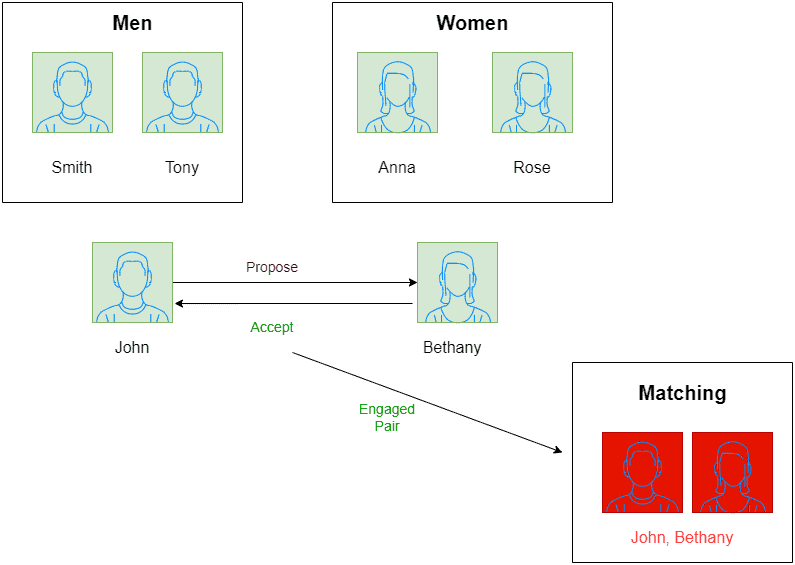
Let be the next free man to match.
proposes to
but since
prefers
over
, she rejects him:
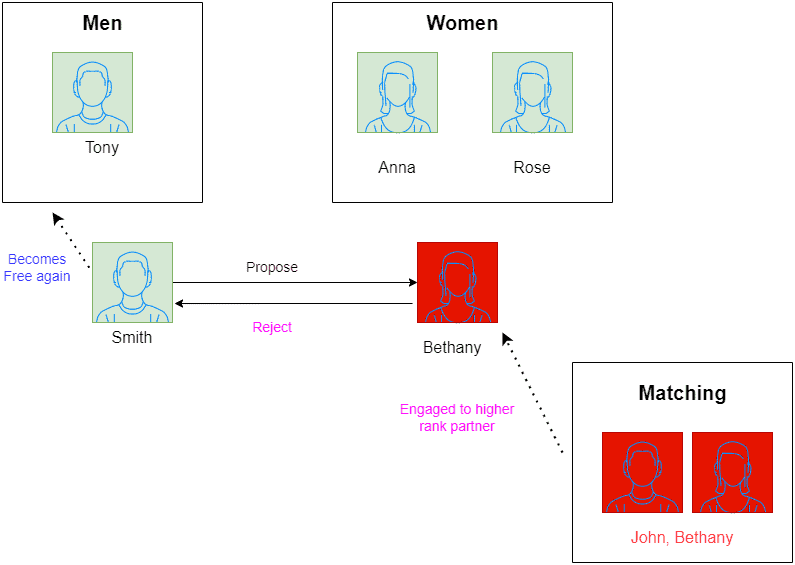
Let’s say we randomly chose again in the next iteration. Now, he proposes to
, who is next on his priority list.
is free, so she accepts, and we get a new pair
, which we add to
to get
:
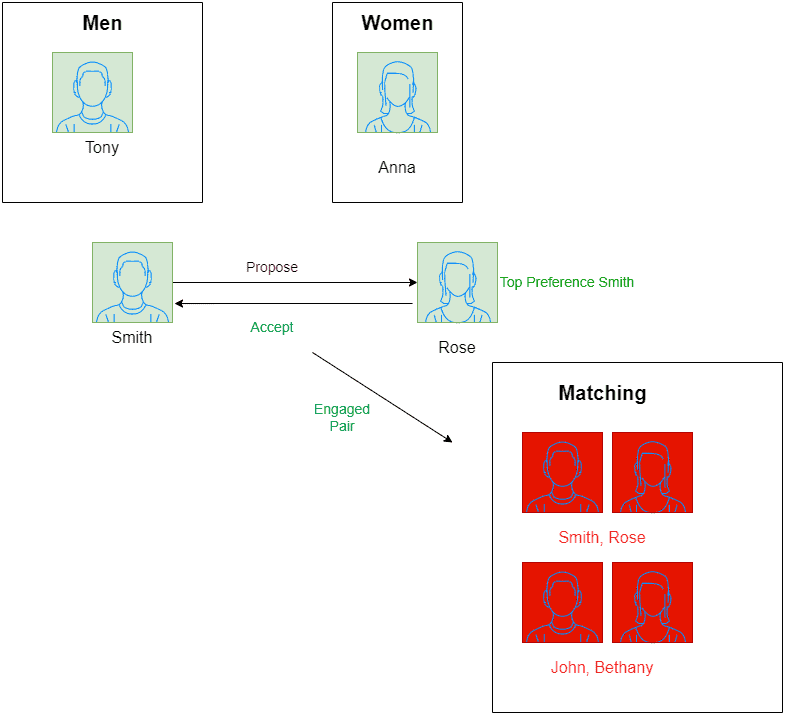
Next, our only choice is since he’s our last free man. He proposes to
but since
prefers
over
, she refuses
and stays with
:
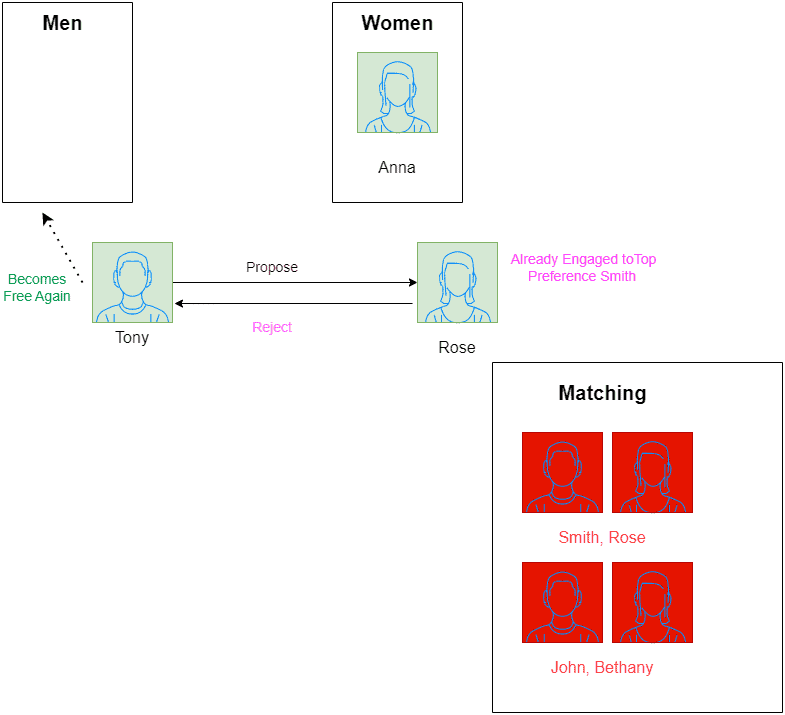
Then, Tony proposes to . Since
prefers
the most, she ditches
and accepts
. So, our matching changes to
:
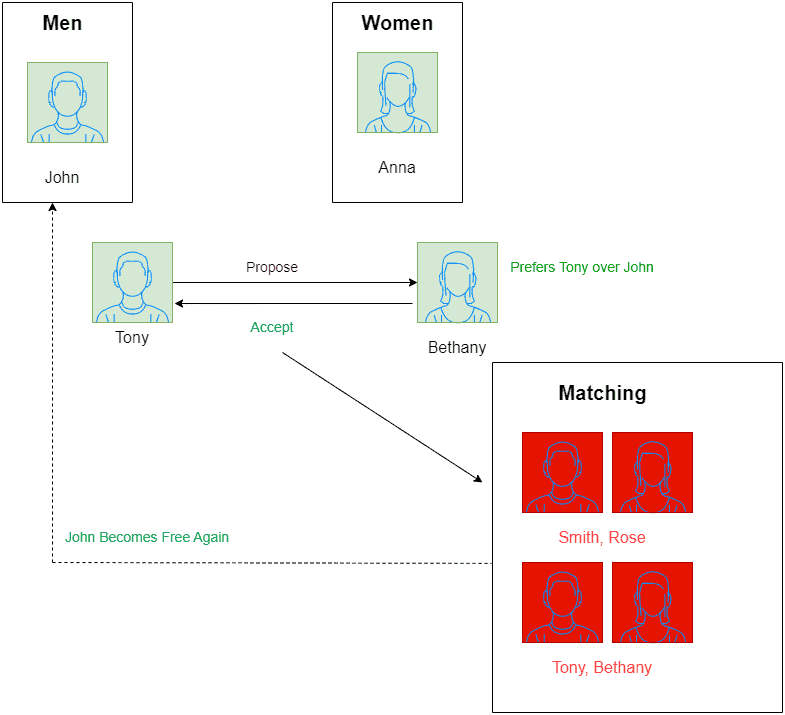
Now, we pick as the next free man. Since
already rejected
,
proposes
, the next girl on his ranking list.
is free, so she accepts the proposal. As a result, we get the matching
:
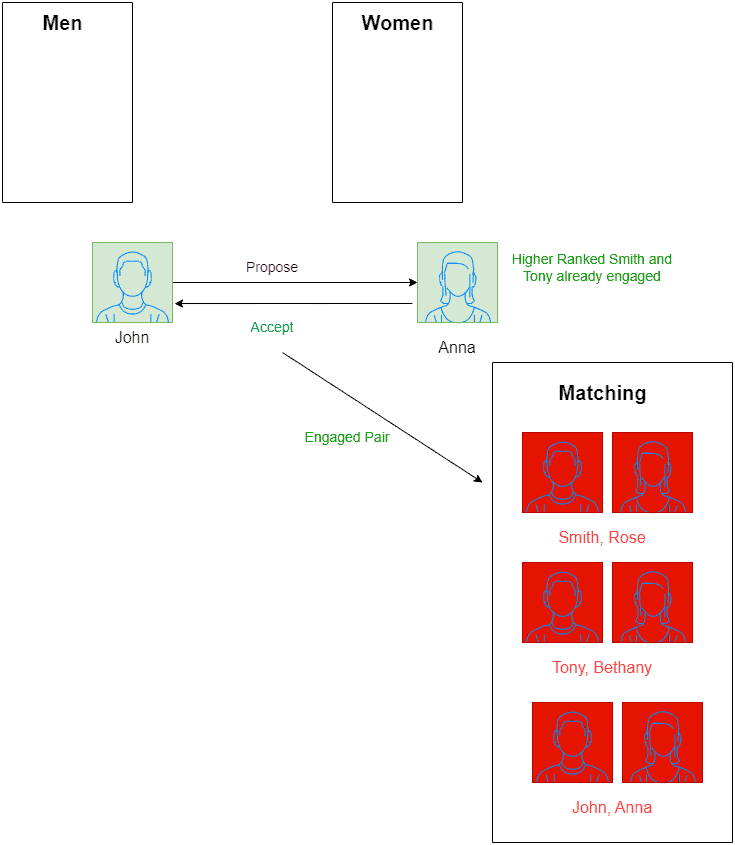
We stop here since no man is free anymore.
6. Theory
In this section, we talk about the correctness of this algorithm and prove that it always terminates.
6.1. The Algorithm Always Terminates
This algorithm terminates after iterations at most.
Why? Because we start with free men, each of which has a preference list of
women. Thus, we have the total of
women in the matrix of the men’s preferences. In each iteration, we take one man, and that man proposes to one woman in the order of preference. Irrespective of the woman accepting or refusing, we reduce the total number of women in his preference list by 1. This is so because we rule out any man proposing to the same woman more than once by removing any woman he proposed to from his preference list.
Hence, our algorithm must terminate after at most iterations. In the end, each man gets matched to a unique woman.
6.2. Correctness
Now, we show that our final matching is a stable marriage matching. The termination property shows that each man in
is matched to a unique woman in
. So, we need to show the stability of this assignment.
We prove this by contradiction. Let’s say that is unstable. So, this implies that a blocking pair
exists such that both partners prefer each other but aren’t matched in
. So, in
, we have man
matched to another woman
and woman
matched to another man
.
Further, proposes to every woman on his ranking list (sorted from the highest to the lowest preference order), and
got included in
before
. So, we know that
must have proposed to
before proposing to
. That’s only possible if he prefers
to
. However, that’s a contradiction since we assumed there’s a blocking pair in which he prefers
to
. As a result, we conclude no blocking pair can exist, which proves the matching
this algorithm returns is stable.
7. Space and Time Complexity
This algorithm has time complexity of . In the worst case, each man finds his match after proposing to all the other women. So, we make
iterations for each man and
to change their respective partners. Hence, the time complexity is
. However, a necessary assumption is that women can compare two men in constant time.
The space complexity of this algorithm is since the male and female preference lists require
space.
8. Real World Application
This problem can have multiple real-world applications.
First, this algorithm can match first-time resident doctors to hospitals. Each participating hospital and resident doctor prepares their preference list. Then, the algorithm for stable marriages matches the residents-to-be with hospitals to get a stable matching.
Second, we can use this to help the central admission system to match students with universities as per the students’ and universities’ preference lists. Since this algorithm is stable and always terminates, we guarantee that a student gets a school from his preference list. Further, the student can’t secure admission to a more preferred school (than what he got from the system) by manipulating their preferences. This is how the admissions system works in India for most engineering schools.
9. Conclusion
In this tutorial, we studied the stable matching problem. The goal is to find a stable matching for elements of two sets (each having elements) based on each element’s given matching preferences. We can solve it in
time and
space.